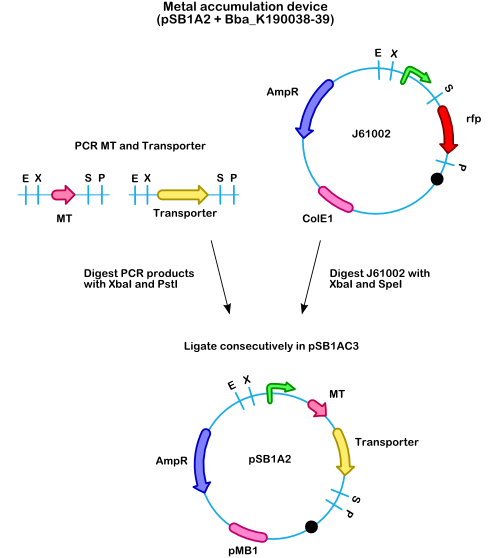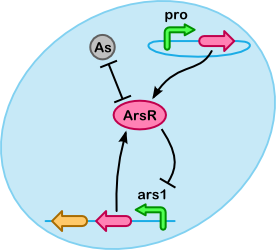Team:Groningen/Project/Accumulation
From 2009.igem.org
(→SmtA) |
m (→Zinc) |
||
| Line 55: | Line 55: | ||
==Zinc== | ==Zinc== | ||
| - | Below toxic concentrations, zinc is essential for many biological processes. | + | Below toxic concentrations, zinc is essential for many biological processes. Examples are enzymatic hydroxylation, DNA and RNA synthesis, transcription and translation, signal transduction and apoptosis regulation ([[http://en.wikipedia.org/wiki/Zinc 1]] and [[Team:Groningen/Literature#Blindauer2001|Blindauer 2001]]). Methallothioneins can adjust the zinc absorption upto 14-40%, though a real excess of zinc can be toxic. A daily intake of 100–300 mg Zn/day can give rise to copper / iron deficiency and damage of nerve receptors ([[Team:Groningen/Literature#Fosmire1990|Fosmire 1990]]). |
Examples of metallothioneins able to bind zinc, are SmtA from the cyanobacterium ''Synechococcus'' PCC7942 ([[Team:Groningen/Literature#Blindauer2001|Blindauer 2001]]), ZiaR from the cyanobacterium ''Synechocystis'' PCC 6803 ([[Team:Groningen/Literature#Robinson2001|Robinson 2001]]), human metallothioneins like MT-1 and -2. The mammalian proteins were found to bind 7 Zn<sup>2+</sup> ions by the thiolate-group of there cysteins. | Examples of metallothioneins able to bind zinc, are SmtA from the cyanobacterium ''Synechococcus'' PCC7942 ([[Team:Groningen/Literature#Blindauer2001|Blindauer 2001]]), ZiaR from the cyanobacterium ''Synechocystis'' PCC 6803 ([[Team:Groningen/Literature#Robinson2001|Robinson 2001]]), human metallothioneins like MT-1 and -2. The mammalian proteins were found to bind 7 Zn<sup>2+</sup> ions by the thiolate-group of there cysteins. | ||
Revision as of 19:09, 17 October 2009
[http://2009.igem.org/Team:Groningen http://2009.igem.org/wiki/images/f/f1/Igemhomelogo.png]
|
|---|
- Transport
- Accumulation
- Metal-sensitive Promoters
- Gas Vesicles
Introduction
Once heavy metals have entered the cell, it is crucial to keep them there. As these metals are toxic to cell survival in critical amounts, evolution has provided us with biological detoxicification proteins such as [http://en.wikipedia.org/wiki/Metallothionein metallothioneins]. These proteins can aid us in our quest to accumulate a variety of heavy metals as they bind to a wide range of metals including cadmium, zinc, mercury, copper, arsenic, silver, etc..
Metallothioneins
Metallothioneins are a class of low molecular-weight metal-binding proteins (<10kDa) rich in cysteines residues(~30%). The contain a conserved cys-x-cys or cys-x-his motif which coordinates metal binding. They are capable of binding a variety of heavy metals (e.g. Zn, Cu, Cd, Hg, As) with high avidity (Kb), they are in vivo used as a defense against oxidative stress by chelating metals. This proteins do also have a function in storing, detoxify and distributing metals throughout the cell (Merrifield 2004, Gold 2008). These proteins have readily been used to create cell based systems for purification of contaminated water (Chen 1998, Brady 1994). In addition to their wide application possibilities, they also have the capacity to carry multiple metal ions at one time, in contrast to some other metalloproteins that carry them one-on-one (Chang 1998). Many forms of metallothioneins are known and their affinity for different metals has been investigated on several occasions, such as for cadmium (Deng 2007), arsenic (Ngu 2006, Kostal 2004, Singh 2008), mercury (Chen 1998, Chen 1997-2, Deng 2008), nickel (Deng 2003) or a combination of metals (Chang 1998, Kao 2008). Metal-protein complexes can be quantified using a fluorescent molecule (Cadosch 2008).
Cloning strategy
- Figure 1: Cloning strategy for the metal accumulation device. A promoter taken from will be cloned in front of a metallothionein and a metal transporter in a vector. This device will be combined with the floating device.
In order to have a functional accumulation device, the cDNA of a metallothionein (MT) will be amplified using [http://en.wikipedia.org/wiki/PCR PCR] and cloned into , also a corresponding metal-ion transporter was amplified by PCR and cloned behind the MT. Both will expressed by one promoter (constitutive or lactose inducible). In this way the bacterium will take up the metal-ion and consecutively the metal-ion will be sequestered by the MT. When this device is combined with the floating device, the bacteria will start floating when a certain threshold of intracellular metal concentration is reached, because the negative regulator of the buoyancy device will be released and the gas vesicle cluster can be transcribed.
Metals
Arsenic
For the accumulation of arsenic some MTs are possible, like rh-MT (human MT) (Ngu 2006) and fMT (the seaweed species Fucus vesiculosis) both binding As(III). The oxidized version of arsenic (As (V)) can also be bound by the metallothioneins but with lower affinity (Singh 2008), another way As(V) is proposed to be accumulated is by conversion of As(V) to As(III) by the arsenate reductase and subsequent bound to the metallothionein or ArsR. rh-MT is known to bind 6x As(III) per molecule, fMT binds 5x As(III). No extra quantitative information is known from literature.
ArsR
ArsR is a trans-acting repressor that senses environmental As(III)and regulates the chromosomal ars operon. The ArsR protein has a specific binding site for As(III) and discriminates effectively against other metals like: phosphate, cadmium, sulfate and cobalt. The affinity of ArsR for As(III) is very high 10-15M of AS(III) can induce the promotor. The specific binding site spans 33 nucleotides in the promotor region including the putative -35 promotor element. When ArsR was purified, its size corresponded to that of a homodimer, bound to promoter DNA. Because of the high affinity of ArsR for As(III) the protein could be used for arsenic remediation. Chen and co-workers overexpressed ArsR in E. coli JM109 cells and found that the specific AS(III) content was 13-fold higher than the control without ArsR expression. High level expression of ArsR appeared to be toxic as a 3-fold reduction in cell density was observed. It has been shown that fusion partners reduce the toxicity of overexpression. Originally, Chen and co-workers made a fusion between ArsR and ELP (elastin protein), which is build out of VPGVG repeats. Because making a ArsR ELP153 fusion is very time consuming, we choose to make a fusion between MBP (maltose binding protein) and ArsR (Chen 1998).
Also see the sensitive promoters.
As ordering rh-MT was not successful, we try to use fMT for accumulation of As(III) and use ArsR to regulate the expression of the GVP cluster behind the ArsR regulated promoter.
fMT
The Fucus [http://www.bioc.uzh.ch/mtpage/intro.html Metallothionein] (fMT) was isolated from the [http://en.wikipedia.org/wiki/Seaweed macroalgae] [http://en.wikipedia.org/wiki/Fucus_vesiculosus Fucus vesiculosus ](Morris 1999). It consists of 67 amino acid residues and has 16 cysteine residues, a high cysteine content is a key feature of MT. Another characteristic is the lack of aromatic residues is also seen in fMT where it only has one, tryptophan. Two domains containing cysteine residues are presumed to be involved in the metal binding function. Unusual in fMT is the presence of a 14 amino acid linker region between the two putative metal-binding domains which contains no cysteine residues. Plant MTs show this feature with about 40 residues, where vertebrate MTs only have three residues (Morris 1999). BUSY
Copper
MymT
MymT is a 5kDa-protien which binds Cu(I) but also to less extend Zn(II?) from Mycobaterterium tuberculosis. This MT was found to bind 4-6Cu(I) ions per molecule. Induction of the expression of MymT is the strongest with Cd and Cu. But upon over-expression of MymT in E. coli, the protein becomes insoluble (Gold 2008). This may be caused by the fact that it is a protein from a gram-positive bacteria expressed in a gram negative bacterium. Therefore specialized cultivation conditions are needed, the cells should be grown at a low temperature (16 °C). The functionality of MymT can be measured by fluorescence spectroscopy, as also found for other copper binding methallothioneins. Cu bound to MT creates a Cu-thiolates which can be excited at 280nm and gives a Stokes shift towards 600nm (Beltramini 1981).
Results: PCR on mymT from pGB68 unfortunately did not give any correct cDNA fragments, even though the primer quality was improved (Protocol Biobrick primers). Therefore the sub-project was discontinued.
Zinc
Below toxic concentrations, zinc is essential for many biological processes. Examples are enzymatic hydroxylation, DNA and RNA synthesis, transcription and translation, signal transduction and apoptosis regulation (http://en.wikipedia.org/wiki/Zinc 1 and Blindauer 2001). Methallothioneins can adjust the zinc absorption upto 14-40%, though a real excess of zinc can be toxic. A daily intake of 100–300 mg Zn/day can give rise to copper / iron deficiency and damage of nerve receptors (Fosmire 1990).
Examples of metallothioneins able to bind zinc, are SmtA from the cyanobacterium Synechococcus PCC7942 (Blindauer 2001), ZiaR from the cyanobacterium Synechocystis PCC 6803 (Robinson 2001), human metallothioneins like MT-1 and -2. The mammalian proteins were found to bind 7 Zn2+ ions by the thiolate-group of there cysteins.
SmtA
Synechococcus is a gram negative bacterium, which increases the posiblity of functional and stable overexpression in E. coli(Blindauer 2001).
Alternatives
Inclusion bodies (Fowler 1987)
(Bacterio)Ferritins
Phytochelatins
[http://www.wiley.com/legacy/products/subject/reference/messerschmidt_toc.html A list of opportunities]
Modelling
Arsenic - ArsR
Below you can calculate how many grams of arsenic will be taken out of the water per cubic meter of cells. This extra weight raises the density of the cell and therefore lowers its capacity for buoyancy. Our preliminary results look very promising. Even under the assumption that the weight of the metal is added to the weight of the cells, without increasing their volume, we could add up to a hundred times the currently computed weight without having a large effect on the required fraction of gas vesicles (it will only go up from about 12.2% to 12.7%).
At this moment we use four different variables:
- Molecular weight of arsenic. Source: [http://en.wikipedia.org/wiki/Arsenic Arsenic page on Wikipedia]
- Millimol arsenic per kg of cell dryweight (note that this is equivalent to nmol/mg). Source: Kostal 2004
- The proportion between the weight of a dry cell and a wet cell. Source: [http://redpoll.pharmacy.ualberta.ca/CCDB/cgi-bin/STAT_NEW.cgi CCDB Database]
- Cell density. Source: see our gas vesicle page.
| As per cell volume = awAs * nAs(III) / Mcell(dry) * Mcelldrywet * rhocell mol As per cell volume = nAs(III) / Mcell(dry) * Mcelldrywet * rhocell |
At a lower level arsenic accumulation can be described using reactions between ArsR, As(III) and the ars promoter. As shown in the figure on the right, a number of different substances(/complexes) are involved. For our purposes it is especially important to determine what fraction of As(III) is unbound, if more As(III) is bound we can accumulate more.
In addition to binding to As(III), ArsR can repress Ars, creating a negative feedback loop. In effect this regulates the production of ArsR based on the As(III) concentration (Chen 1997). In the E. coli top 10 there is only ars promoter present on the genome to produce ArsR (see BLAST results). There are plasmids which produce both ArsR and ArsD, but these are not used in this project. We intend to introduce instead a constitutive promoter (pro), which produces just ArsR, in order to bind as much As(III) as possible.
The calculator below tries to compute the ratio between bound and unbound arsenic, specifically As(III), in the cell. See our Modelling page for detailed information on the constants/variables used and a derivation of the formulas. Note that the computations currently involve slightly more variables/constants than strictly necessary.
|
In conclusion:
- Even at the accumulation levels of Koster et al. the amount of arsenic accumulated in E. coli is so little that it should not matter much for the buoyant density (which normally is about 1100kg/m3).
- If you substitute constitutive promotors for Ars promotors, you can see that it is clearly advantageous to use constitutive promotors as just adding ars promoters does not increase the accumulation factor. A plasmid containing an ars promoter and (just) a gene coding for ArsR behind it might contain more arsenic, but there would also be more unbound arsenic, increasing the toxicity.
- The model is not very sensitive to different values for K3d (with K3d=1mM the accumulation factor is 248.06 and with K3d=1nM it is 240.57).
- The accumulation factor is greatly affected by the product of the half-life of ArsR and the production rate.
 "
"








